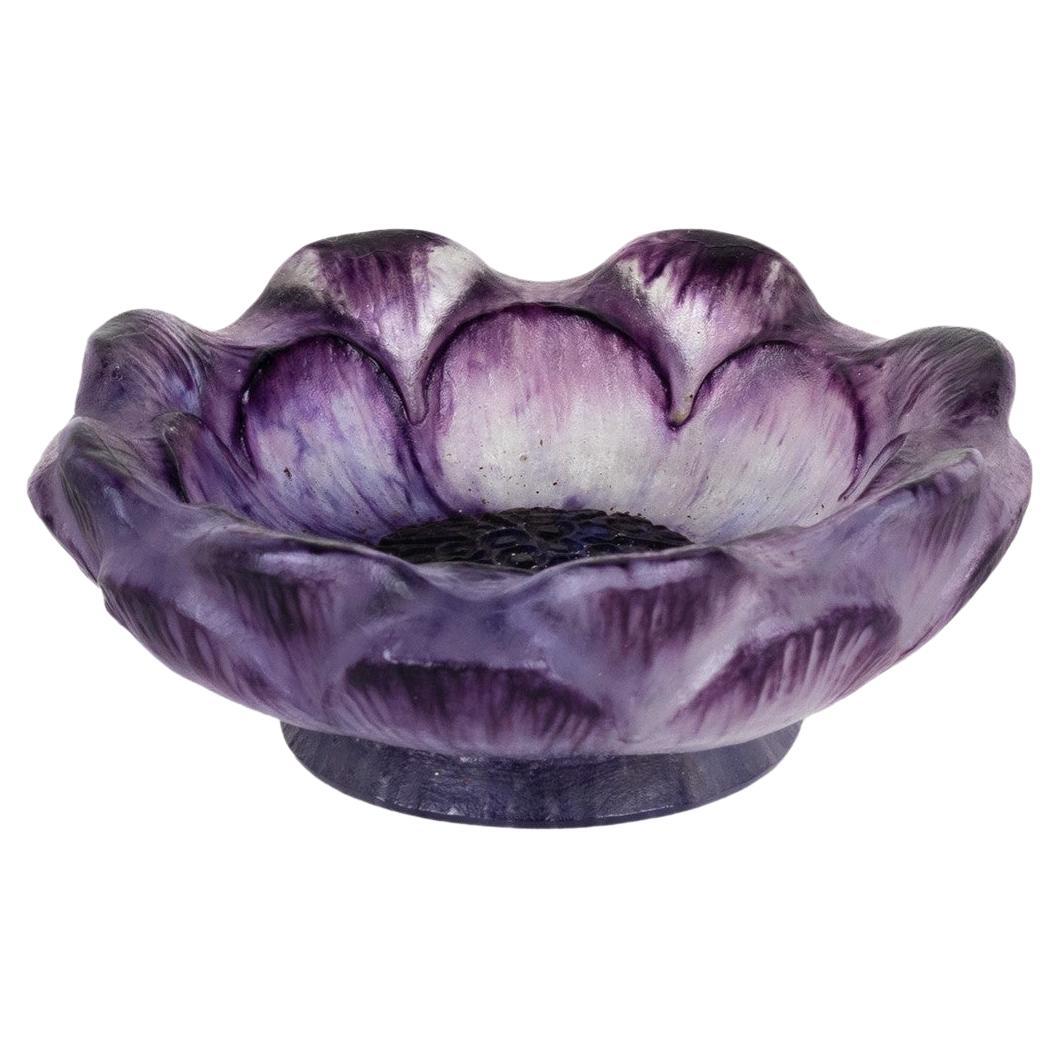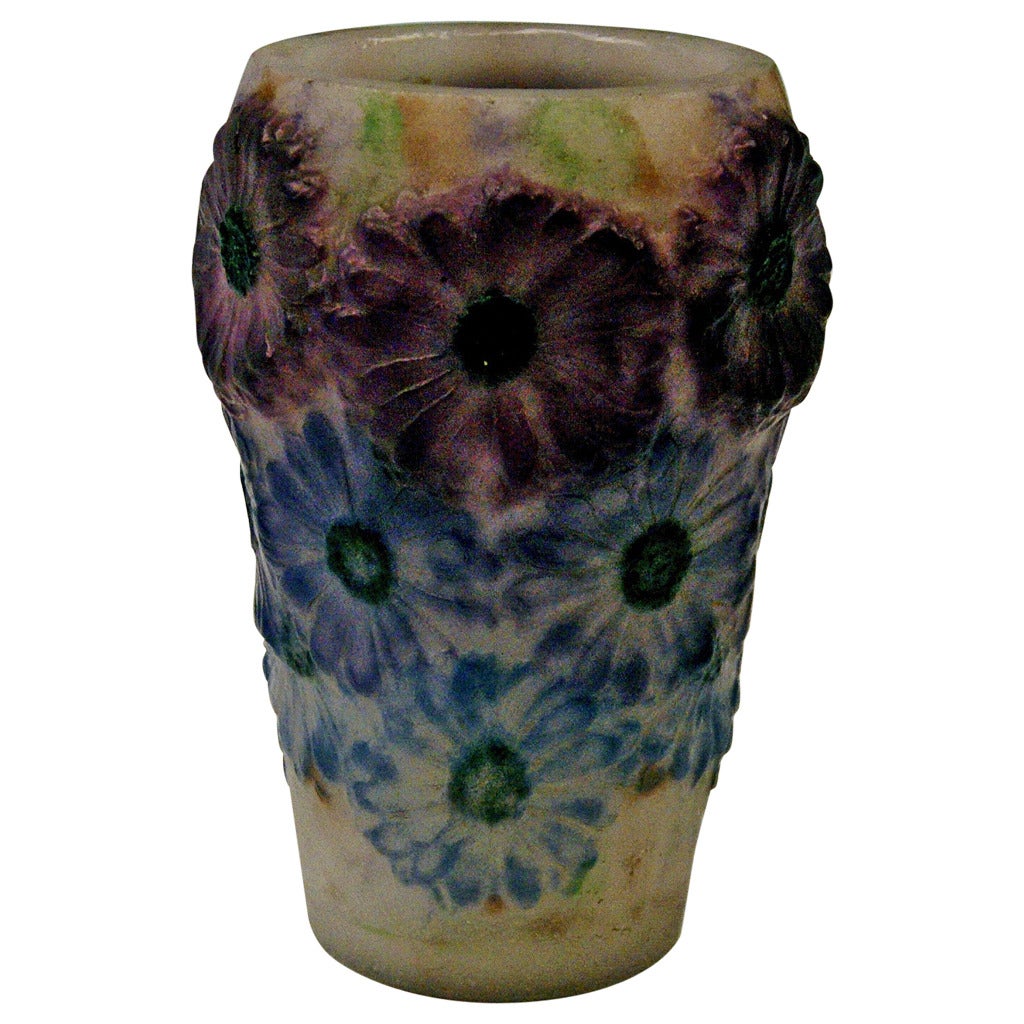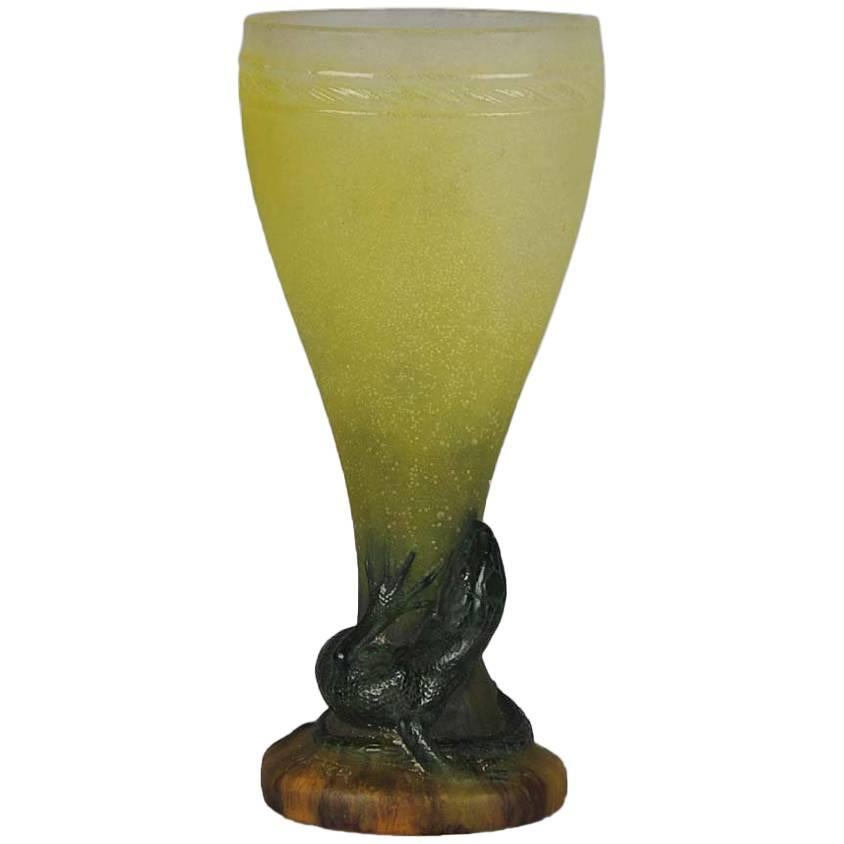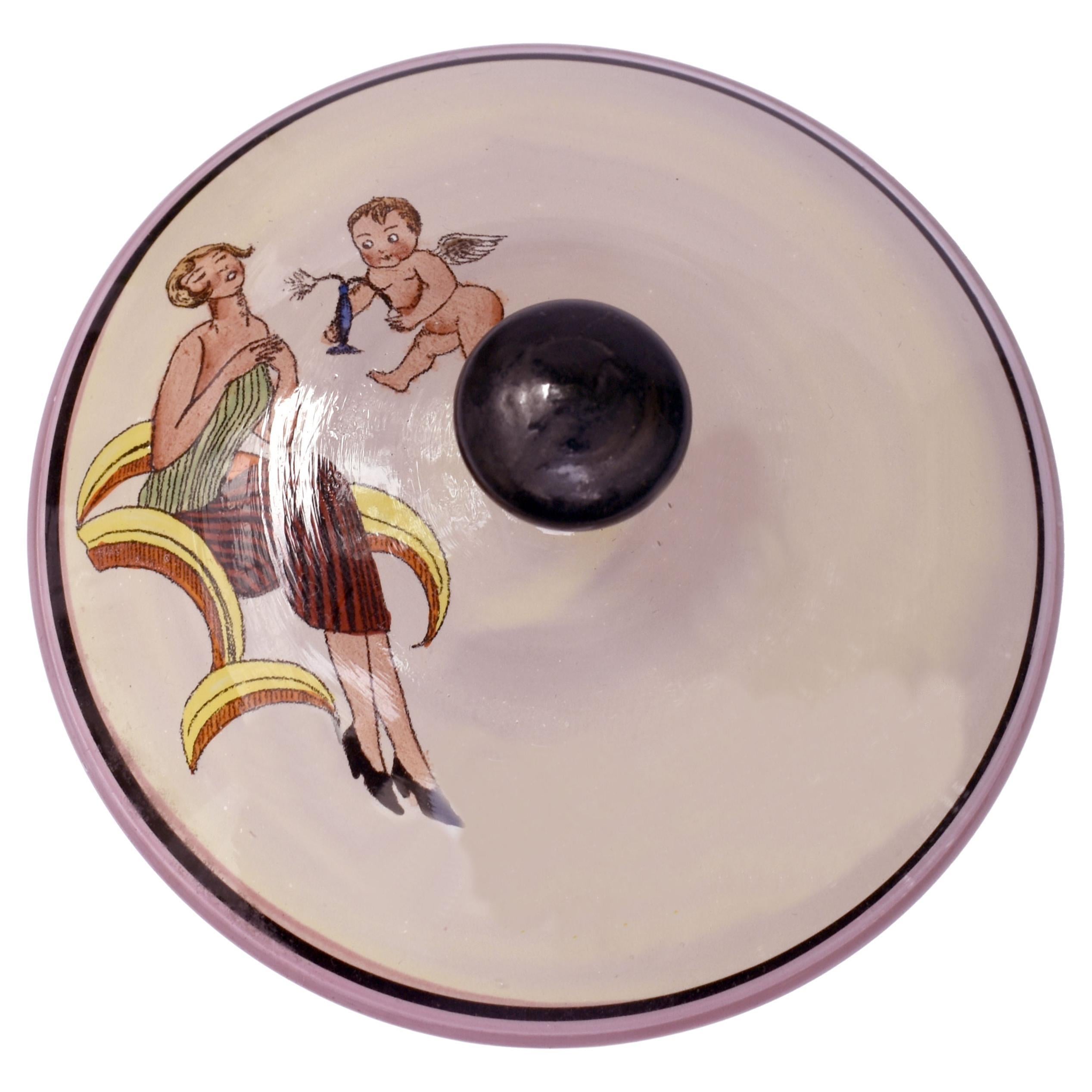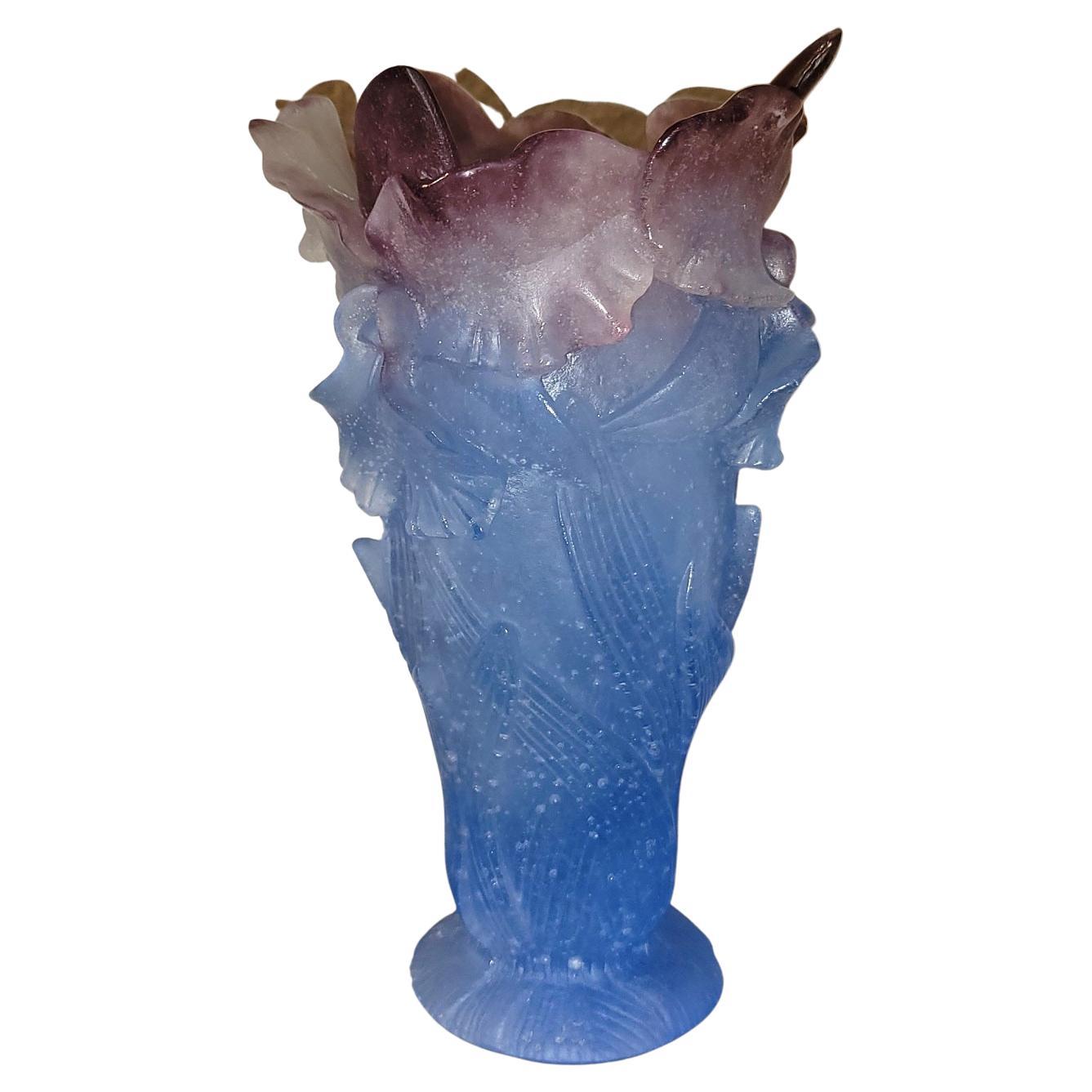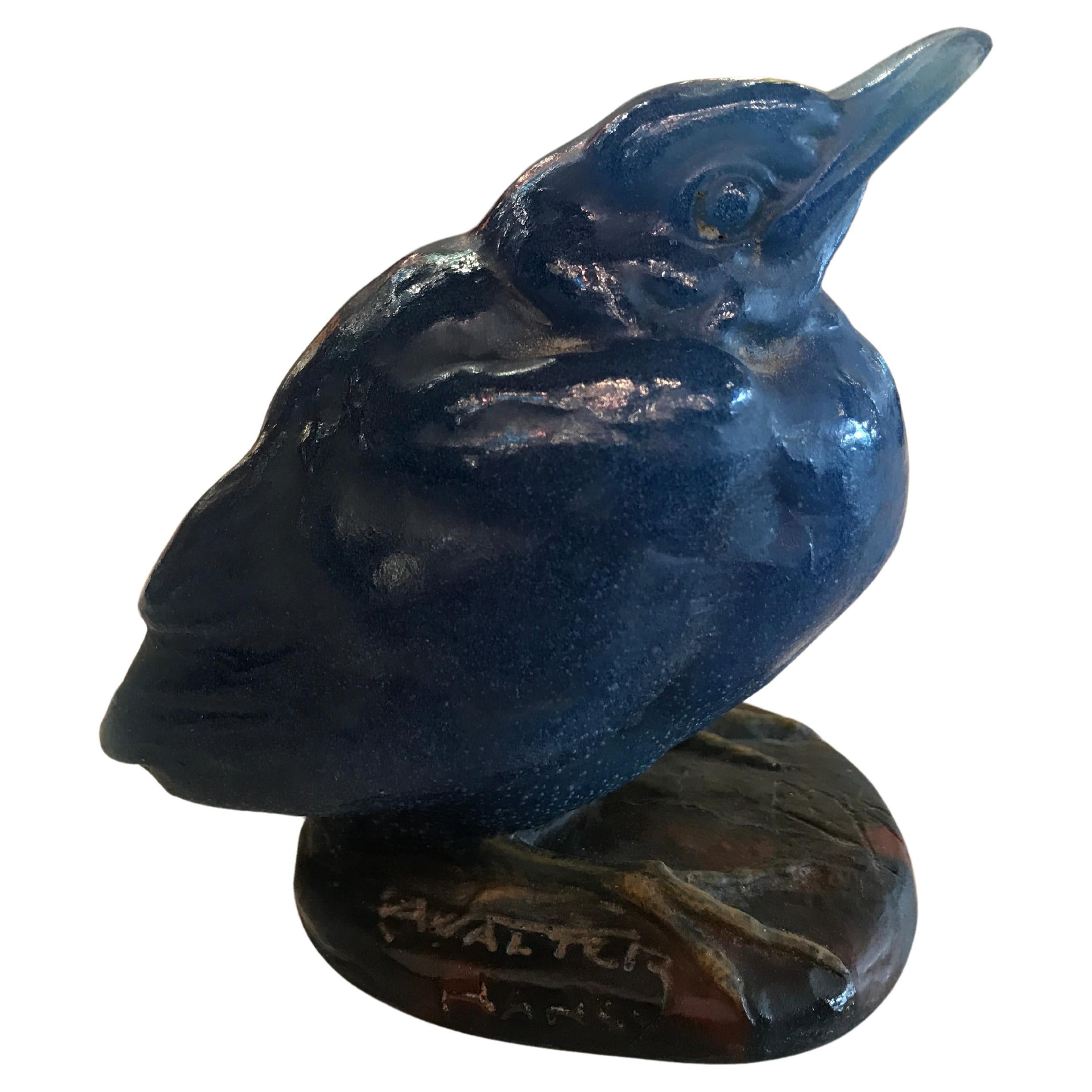Items Similar to Art Deco Pâte De Verre Bowl 'Ceres' by Gabriel Argy-Rousseau, Paris, ca 1925
Want more images or videos?
Request additional images or videos from the seller
1 of 7
Art Deco Pâte De Verre Bowl 'Ceres' by Gabriel Argy-Rousseau, Paris, ca 1925
About the Item
Bulbous bowl of colorless pâte de verre with colored powder inclusions in yellow, red & black, relief decoration with stylized ears of grain and geometric triangle and diamond pattern. Signed 'G. Argy-Rousseau' on the body, 'FRANCE' pressed on the underside of the base.
Manufactory: Société Anonyme des Pâtes de Verre d'Argy-Rousseau, Paris, France
Dating of manufacture: circa 1925
Designer:
Joseph Gabriel Argy-Rousseau (1885-1953) was a French Art Nouveau and Art Deco glass artist and ceramist. In the École Nationale des Céramiques de Sèvres (from 1902) he met the son of the pioneer of the pâte de verre technique, Henry Cros. He first worked in a research laboratory to develop dental porcelain, after which he devoted himself exclusively to pâte de verre glass art. After his marriage, he took part of his wife's maiden name (Argyriadès) and henceforth called himself 'Argy-Rousseau'. He took part very successfully in the Salons des Artistes Français in Paris. In 1921 he met the gallery owner and glassworks owner Gustave Gaston Moser-Millot, with whom he founded the Société Anonyme des Pâtes de Verre d'Argy-Rousseau. Argy-Rousseau never disclosed its manufacturing process of pâte de verre and retained the exclusive rights. Nature was
an important theme in his work, in which he primarily depicted flowers, insects, animals and female forms. Many of his vases were entwined with flowers at the top. From 1917 onwards, the forms of his works became longer, reflecting the influence of Japanese art. Scenes from ancient mythology (as in Le Jardin des Hespérides) were also common motifs. He often varied the thickness of the glass and, depending on the design, from semi-transparent to opaque.
Technique:
Pâte de verre (English glass paste) is a technique used in the production of multi-colored glass. A cold-formed paste made of glass powder and dyes is filled into a refractory mold and then fired in a muffle furnace, whereby the glass melts into the desired shape. To achieve polychrome color effects, the process is repeated with other colors. The technique was already known in ancient Rome and Egypt. Particularly in the Art Nouveau period and later in the Art Deco period, she found artistic use again in works by French glass artists such as Gabriel Argy-Rousseau, Henry Cros, Albert Dammouse, François Décorchemont, Amalric Walter, Émile Gallé and George Despret.
Size:
Height: 8.0 cm / 3.14 in
Diameter: 11.5 cm / 4.52 in
Bibliography:
Janine Bloch-Dermant, Argy-Rousseau, page 208, No. 26.04.
Condition: very good.
- Creator:Gabriel Argy-Rousseau (Manufacturer)
- Dimensions:Height: 3.15 in (8 cm)Diameter: 4.53 in (11.5 cm)
- Style:Art Deco (Of the Period)
- Materials and Techniques:Glass,Cast
- Place of Origin:
- Period:
- Date of Manufacture:circa 1925
- Condition:
- Seller Location:Vienna, AT
- Reference Number:1stDibs: LU1014427232672
About the Seller
5.0
Gold Seller
These expertly vetted sellers are highly rated and consistently exceed customer expectations.
Established in 1988
1stDibs seller since 2013
279 sales on 1stDibs
Typical response time: 5 hours
- ShippingRetrieving quote...Ships From: Vienna, Austria
- Return PolicyA return for this item may be initiated within 7 days of delivery.
More From This SellerView All
- Art Deco Vase with Marigolds by Gabriel Argy-Rousseau, France circa 1920By Gabriel Argy-RousseauLocated in Vienna, ATArt Deco Rarest Vase with Marigolds Flowers / Pâte de Verre MANUFACTORY: GABRIEL ARGY-ROUSSEAU / made in France / Paris, circa 1920 - 1925 DESIGNER: GABRIEL ARGY-ROUSSEAU ...Category
Vintage 1920s French Art Deco Vases
MaterialsGlass
- Art Nouveau Pâte De Verre Vide-Poche 'Deux Poissons', Amalric Walter, FranceBy Amalric WalterLocated in Vienna, ATDecorative pâte-de-verre vide-poche: bowl in yolk yellow, one side overflowing in dark blue, swimming around each other, plastically formed goldfish couple. Signed 'AWALTER NANCY' on the top. Manufactory: Amalric Walter, Nancy, Lorraine, France Dating of manufacture: circa 1920/1925 Designer: VICTOR AMALRIC WALTER (1870-1959) was a French glass manufacturer mainly known for his pâte de verre pieces. In the Cristalleries Daum at Nancy, France, he met the designer and modelist HENRI BERGÉ, with whom he produced the first pâtes de verre, which at the time were only signed with "Daum Nancy". After the war he continued to work with Henri Bergé. From 1919 to 1935 he cast no fewer than 500 models with Bergé and other famous sculptors or designers, always in few numbers due to the sophisticated technique of glass kiln casting. Technique: Pâte de verre (English glass paste) is a technique used in the production of multi-colored glass. A cold-formed paste made of glass powder and dyes is filled into a refractory mold and then fired in a muffle furnace, whereby the glass melts into the desired shape. To achieve polychrome color effects, the process is repeated with other colors. The technique was already known in ancient Rome and Egypt. Particularly in the Art Nouveau period and later in the Art Deco period, she found artistic use again in works by French glass artists such as Gabriel Argy-Rousseau, Henry Cros...Category
Vintage 1920s French Art Nouveau Glass
MaterialsGlass
- Camille Fauré, Spherical Art Déco Enamel Vase with Ornamental Decor, France 1925By Camille FauréLocated in Vienna, ATSpherical vessel on a round, grooved metal stand, coated in silver and with pasty applied, polychrome and iridescent geometric-floral enamel decoration in blue-turquoise and brownish-orange, irregularly glazed, inscribed 'C. FAURÉ LIMOGES FRANCE...Category
Vintage 1920s French Art Deco Glass
MaterialsMetal, Enamel
- Emile Galle Vase Paysage de Verre Gallé Nancy Art Nouveau France, 1900-1904By Emile GalléLocated in Vienna, ATGallé Nancy Art Nouveau finest vase made in France (Nancy, Lorraine) / circa 1900-1904 Specifications: Stunningly manufactured casing glass (colorless glass with various layers:...Category
Antique Early 1900s French Art Nouveau Glass
MaterialsGlass
- Emile Galle Vase Paysage De Verre Gallé Nancy Art Nouveau, France, circa 1919By Emile GalléLocated in Vienna, ATGallé Nancy Art Nouveau finest vase made in France (Nancy, Lorraine) made circa 1919-1920 Specifications: Stunningly manufactured casing glass (colorless glass with various lay...Category
Vintage 1910s French Art Nouveau Glass
MaterialsGlass
- Daum Frères Nancy Cameo Vase by Georges de Feure Frieze Figurines 1925By Georges De Feure, DaumLocated in Vienna, ATDaum Frères Nancy / Lorraine / France Rarest Cameo Vase With Frieze Decoration Running Around Made circa 1920-1930 (= Transition Period From Art Nouveau To Art Deco) Design & ...Category
Vintage 1920s French Art Nouveau Glass
MaterialsGlass
You May Also Like
- Purple Flower Glass Bowl by Gabriel Argy Rousseau, 1924By Gabriel Argy-RousseauLocated in Lisbon, PTPate-de-verre 'Open Flower' purple glass vase/ bowl. Circa 1924. Modeled and cast as an open flower head, on a short foot (restored) with ‘G. Argy-Rousseau’ signature. Literature...Category
20th Century French Art Nouveau Glass
MaterialsArt Glass
- Art Deco Pate-De-Verre Glass 'Lizard Vase' by Amalric WalterBy Amalric WalterLocated in London, GBA fantastic and very rare early 20th century pate-de-verre glass vase decorated with a lizard coiled around the bottom with a very fine orange and green color that fades out into yel...Category
Vintage 1920s French Art Deco Glass
MaterialsArt Glass
- Art Deco Glass Lidded Powder Bowl, c1930Located in Devon, EnglandFor your consideration is this charming 1930's Art Deco glass powder bowl in pink glass. To the lid is flapper girl in the fashion of the day next to a fly...Category
Mid-20th Century English Art Deco Glass
MaterialsGlass
- Daum Orchid Amethyst Pate de Verre VaseBy DaumLocated in Dallas, TXPRESENTING A STUNNING Daum Orchid Amethyst Pate de Verre Vase. Made by the World renowned French maker of ‘Daum’ of Nancy, France circa 1960-80. Gorgeous art glass piece, hand craf...Category
Mid-20th Century French Art Nouveau Glass
MaterialsArt Glass
- Art Glass, A. Walter, (Pâte de verre vide-poche by Amalric Walter), FranceBy Almeric WalterLocated in Ciudad Autónoma Buenos Aires, CPâte de verre vide-poche by Amalric Walter. Born in Sèvres on May 19, 1870, Walter first worked at the Manufacture nationale de Sèvres, near Paris, where he decorated and glazed ear...Category
Vintage 1920s Austrian Art Nouveau Figurative Sculptures
MaterialsArt Glass
- Large Midcentury French Pâte de Verre or Molten Art Glass VaseLocated in Miami, FLBeautiful French pâte de verre or molten art glass vase. This lovely decorative piece was handcrafted with striking details. Double layered blown glass vase in white, light blue ...Category
20th Century French Mid-Century Modern Glass
MaterialsArt Glass
Recently Viewed
View AllMore Ways To Browse
Silver Color Diamond
Paris Furniture Galleries
1925 Silver
Cast Glass Top
Egypt Glass
Opaque Art Glass
English Silver Manufacturing
Long Glass Bowl
Glass Insects
English Glass Red
Silver Insects
Cold Art Glass
Colored Glass Bowl
French Paste Silver
Art Deco Paris Diamond
Paste Diamonds
Egyptian Made Glass
Egypt Relief
